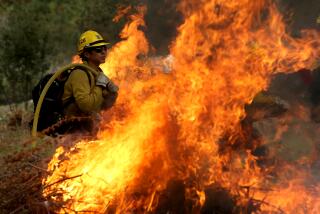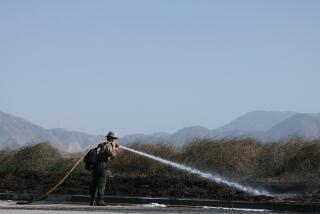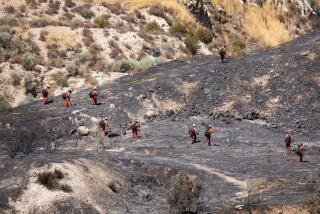As weather cools, firefighters have Powerhouse fire 60% contained
As the weather begins to cooperate, firefighters battling a massive wildfire in Santa Clarita and Lancaster are beginning to gain the upper hand.
The Powerhouse fire is at least 60% contained after burning more than 32,000 acres since starting last week near a power station, the U.S. Forest Service reported.
As the fire burns north into Lancaster, weather forecasters said winds are expected to die down to 15 to 25 mph with temperatures in the mid-80s to low 90s. In the Santa Clarita hills west of Castaic Lake, it’s expected to be 82 degrees.
The conditions are more favorable than what thousands of firefighters have been dealing with since the weekend, when temperatures peaked in the triple-digits and strong winds and dry air made the Antelope Valley mountains a tinderbox.
The fire was pushed by the hot winds and fueled by a potent combination of dense chaparral -- some of which hasn’t burned since 1929 -- and highly flammable grasses.
The fire in this old chaparral, with layer upon layer of dead growth underneath, has proved difficult to fight. Fire crews have found it hard to cut through, officials said, and more water drops from aircraft are needed to extinguish the flames.
“That stuff is so dry it just breaks in your hands,” said Chuck Tobias, spokesman for the Fresno Fire Department as he snapped a gray-white twig and crumbled it between his fingers at the fire base camp Monday. “It lights off like a Roman candle.” Fresno firefighters are among those trying to gain control over the blaze.
There has been much debate over the years about whether modern firefighting practices -- stopping the flames as quickly as possible -- can result in larger wildfires later as brush grows unchecked. In some remote areas of the West, fires are allowed to burn, but Nathan Judy, spokesman for the Forest Service, said Southern California is simply too populated to adopt that strategy.
Chaparral tends to grow taller as it ages, collecting dead material below it, “so it ends up being more volatile,” said Neil Sugihara, a regional fire ecologist for the Forest Service. “The overall fuel load on the site becomes much higher and taller, so you get a lot higher fire intensity and a lot more energy released.”
The brush has been desiccated by a near-record lack of rain this year, and officials expect even worse fires when the traditional Santa Ana wind season begins in the fall.
But firefighters dealing with the current crisis were gaining momentum against the fire.
Temperatures dropped dramatically Monday and humidity levels rose. Even as the afternoon winds began to pick up, whipping the desert dust around the base camp in Palmdale, fire officials announced that the vast majority of evacuees would be allowed back in their homes.
“What a difference a day makes,” said incident commander Dave Richardson of the Los Angeles County Fire Department.
All residents in the Lake Hughes and Elizabeth Lake areas were allowed back home Monday. They were cautioned to be mindful of fallen trees and downed power lines in the area, and those with private wells were advised to boil their water before drinking or cooking with it.
Residents in the Antelope Acres area remain under mandatory evacuation.
ALSO:
Resident returns to home destroyed by Powerhouse fire
LAPD seeks witnesses in three South L.A. fatal shootings
Judge refuses to dismiss Hollywood power broker’s LAPD lawsuit
More to Read
Start your day right
Sign up for Essential California for news, features and recommendations from the L.A. Times and beyond in your inbox six days a week.
You may occasionally receive promotional content from the Los Angeles Times.








